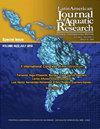Application of microsatellite DNA method in determining the genetic diversity of farmed broodstocks of Penaeus vannamei (Boone, 1931) in hatchery centers of Bushehr Province
IF 0.8
4区 农林科学
Q3 FISHERIES
Latin American Journal of Aquatic Research
Pub Date : 2023-07-02
DOI:10.3856/vol51-issue3-fulltext-3001
引用次数: 0
Abstract
The aim of this study was a detection of different populations of Pacific white shrimp (Penaeus vannamei Boone, 1931) farmed broodstocks and to determine their genetic indexes in hatchery centers of Bushehr province. DNA was extracted from the muscle tissue of 30 broodstocks of 11 stocks using a commercial kit. The repeated sequences were amplified using ten specific primers by PCR in the Iranian Shrimp Center. The results showed that the number of alleles was 4.5-5.5 in the studied stocks. The most allele frequency was observed in the farmed broad stocks of the third stock in the H2 hatchery center, 5.2 ± 0/359. Also, the average of observed heterozygosity in the farmed broad stocks of the second stock in the H5 hatchery center obtained 0.669 ± 0.152, more than other stocks in all centers. Genetics indexes of the farmed broad stocks of the third stock in the H2 hatchery center were increased compared with other stocks in Bucher province. The inbreeding coefficients of the first stocks in the H1 and H3 hatchery centers were significantly more than others, respectively, 0.595 ± 0.105 and 0.547 ± 0.145. The increased inbreeding coefficients of the farmed broad stocks in these stocks can be referred to due to the small size of the founder population and biased selection programs. However, this amount is acceptable according to the information of the other hatchery centers in Bushehr province and other countries. Moreover, it was concluded that broodstock with higher diversity should be used to increase the genetic indicators in the hatchery centers.应用微卫星DNA法测定布什尔省孵卵中心凡纳滨对虾(Boone, 1931)养殖亲鱼遗传多样性
本研究的目的是对布什尔省孵卵中心养殖的太平洋白对虾(Penaeus vannamei Boone, 1931)的不同种群进行检测并确定其遗传指标。使用商业试剂盒从11个鱼种的30条亲鱼的肌肉组织中提取DNA。在伊朗对虾中心用10个特异引物进行PCR扩增。结果表明,所研究群体的等位基因数量为4.5 ~ 5.5个。H2孵化场3号鱼养殖阔鱼的等位基因频率最高,为5.2±0/359。H5孵化场2号鱼群的观察杂合度平均值为0.669±0.152,高于各中心其他鱼群。H2孵化场3号鱼养殖阔鱼的遗传指标较布赫省其他鱼有所提高。H1和H3孵卵中心的第一种群近交系数分别为0.595±0.105和0.547±0.145,显著高于其他孵卵中心。在这些种群中,养殖广域种群近交系系数的增加可归因于创始种群规模小和偏选方案。然而,根据布什尔省其他孵化场中心和其他国家的信息,这个数量是可以接受的。因此,孵化场应选用多样性较高的种鱼来提高遗传指标。
本文章由计算机程序翻译,如有差异,请以英文原文为准。
求助全文
约1分钟内获得全文
求助全文
来源期刊

Latin American Journal of Aquatic Research
FISHERIES-MARINE & FRESHWATER BIOLOGY
CiteScore
1.70
自引率
10.00%
发文量
44
审稿时长
4-8 weeks
期刊介绍:
Latin American Journal of Aquatic Research- LAJAR is the continuation of the journal Investigaciones Marinas (1970-2007) and is published since 2008 by the Escuela de Ciencias del Mar, Facultad de Ciencias del Mar y Geografía of the Pontificia Universidad Católica de Valparaíso. LAJAR is an “Open Access” journal that publishes in English language, original research articles, reviews and short communications on aquatic science, which contain the results of research conducted in aquaculture or in oceanic and coastal marine waters of Latin America.
The following topics are considered: Physical Oceanography, Chemical Oceanography, Marine Biogeochemistry, Marine Pollution and Toxicology, Marine Geology and Geophysics, Biological Oceanography, Fisheries and Aquaculture.
 求助内容:
求助内容: 应助结果提醒方式:
应助结果提醒方式:


